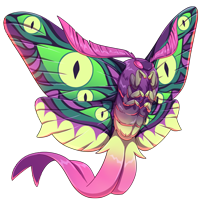

Meihua
(#66150881)
when the old plum tree blooms, the entire world blooms
Click or tap to view this dragon in Predict Morphology.
Energy: 43/50

Expand the dragon details section.
Collapse the dragon details section.
Personal Style

Ancient dragons cannot wear apparel.
Skin
Scene

Measurements
Length
11.15 m
Wingspan
8.9 m
Weight
10859.27 kg
Genetics
Umber
Phantom (Gaoler)
Phantom (Gaoler)
Pink
Rosette (Gaoler)
Rosette (Gaoler)
Blush
Blossom (Gaoler)
Blossom (Gaoler)
Hatchday
Breed
Eye Type
Level 1 Gaoler
EXP: 0 / 245


STR
7
AGI
5
DEF
7
QCK
5
INT
5
VIT
9
MND
7
Biography

Meihua
梅花, 梅
plum blossom
Prunus mume is an East Asian and Southeast Asian tree species classified in the Armeniaca section of the genus Prunus subgenus Prunus. Its common names include Chinese plum, Japanese plum, and Japanese apricot. The flower, long a beloved subject in the traditional painting and poetry of East Asia and Vietnam, is usually called plum blossom. This distinct tree species is related to both the plum and apricot trees. Although generally referred to as a plum in English, it is more closely related to the apricot. In East Asian cuisine (Chinese, Japanese and Korean) and Southeast Asian cuisine (Vietnamese), the fruit of the tree is eaten raw, used in juices, as a flavouring for alcohol, as a pickle and in sauces. It is also used in traditional medicine.
The tree's flowering in late winter and early spring is highly regarded as a seasonal symbol.
Prunus mume is a common fruit in Asia and used in traditional Chinese medicine. It has long been used as a traditional drug and healthy food in East Asian countries.
The plum blossom, which is known as the meihua (梅花), is one of the most beloved flowers in China and has been frequently depicted in Chinese art and poetry for centuries. The plum blossom is seen as a symbol of winter and a harbinger of spring. The blossoms are so beloved because they are viewed as blooming most vibrantly amidst the winter snow, exuding an ethereal elegance, while their fragrance is noticed to still subtly pervade the air at even the coldest times of the year. Therefore, the plum blossom came to symbolize perseverance and hope, as well as beauty, purity, and the transitoriness of life. In Confucianism, the plum blossom stands for the principles and values of virtue. More recently, it has also been used as a metaphor to symbolize revolutionary struggle since the turn of the 20th century.
Because it blossoms in the cold winter, the plum blossom is regarded as one of the Three Friends of Winter, along with pine, and bamboo. The plum blossom is also regarded as one of the Four Gentlemen of flowers, as well as one of the Flowers of the Four Seasons. These two groupings are seen repeatedly in the Chinese aesthetic of art, painting, literature, and garden design.
An example of the plum blossom's literary significance is found in the life and work of poet Lin Bu (林逋) of the Song dynasty (960–1279). For much of his later life, Lin Bu lived in quiet seclusion on a cottage by West Lake in Hangzhou, China. According to stories, he loved plum blossoms and cranes so much that he considered the plum blossom of Solitary Hill at West Lake as his wife and the cranes of the lake as his children, thus he could live peacefully in solitude. One of his most famous poems is "Little Plum Blossom of Hill Garden" (山園小梅).
Legend has it that once on the 7th day of the 1st lunar month, while Princess Shouyang (壽陽公主), daughter of Emperor Wu of Liu Song (劉宋武帝), was resting under the eaves of Hanzhang Palace near the plum trees after wandering in the gardens, a plum blossom drifted down onto her fair face, leaving a floral imprint on her forehead that enhanced her beauty further. The court ladies were said to be so impressed that they started decorating their own foreheads with a small delicate plum blossom design. This is also the mythical origin of the floral fashion, meihua chuang (梅花妝; literally "plum blossom makeup"), that originated in the Southern Dynasties (420–589) and became popular amongst ladies in the Tang (618–907) and Song (960–1279) dynasties. The markings of plum blossom designs on the foreheads of court ladies were usually made with paintlike materials such as sorghum powder, gold powder, paper, jade and other tint substances. Princess Shouyang is celebrated as the goddess of the plum blossom in Chinese culture.
During the Ming dynasty (1368–1644), the garden designer Ji Cheng wrote his definitive garden architecture monograph Yuanye and in it he described the plum tree as the "beautiful woman of the forest and moon". The appreciation of nature at night plays an important role in Chinese gardens, for this reason there are classical pavilions for the tradition of viewing plum blossoms by the moonlight.The flowers are viewed and enjoyed by many as annual plum blossom festivals take place in the blooming seasons of the meihua. The festivals take place throughout China (for example, West Lake in Hangzhou and scenic spots near Zijin Mountain in Nanjing amongst other places). Plum blossoms are often used as decoration during the Spring Festival (Chinese New Year) and remain popular in the miniature gardening plants of the art penjing. Branches of plum blossoms are often arranged in porcelain or ceramic vases, such as the meiping (literally "plum vase"). These vases can hold single branches of plum blossoms and are traditionally used to display the blossoms in a home since the early Song dynasty (960–1279).
The Moy Yat lineage of Wing Chun kung fu uses a red plum flower blossom as its symbol. The plum blossoms are featured on one of the four flowers that appear on mahjong tile sets, where mei (梅) is usually simply translated as "plum" in English.
It has been suggested that the Japanese practice of cherry blossom viewing, Hanami, may have originated from a Chinese custom of poetry and wine under plum blossom trees that was aped by Japanese elites. This is supported by the fact that Hanami started in urban areas rather than rural areas, and that classic Japanese poetry does not associate cherry blossoms with merriness like Hanami. However, the debate is charged with nationalist currents.
The plum blossom has also been proposed to be one of the national flowers for the People's Republic of China, along with the peony.
The National Flower of the Republic of China (Taiwan) was officially designated as the plum blossom (Prunus Mei; Chinese: 梅花) by the Executive Yuan of the Republic of China on July 21, 1964. The plum blossom is a symbol for resilience and perseverance in the face of adversity during the harsh winter. The triple grouping of stamens (three stamens per petal) on the national emblem represents Sun Yat-sen's Three Principles of the People, while the five petals symbolize the five branches of the government. It also serves as the logo of China Airlines, the national carrier of Taiwan (the Republic of China). The flower is featured on some New Taiwan dollar coins.
In Korea, the plum blossom is a symbol for spring. It is a popular flower motif, amongst other flowers, for Korean embroidery. Maebyong are plum vases derived from the Chinese meiping and are traditionally used to hold branches of plum blossoms in Korea.
Originally introduced from China, the Japanese plum (梅, ume; sometimes referred to as Japanese apricot) has played an important role in Japanese culture for many centuries. Its popularity was eventually surpassed by that of the cherry tree.
The plum is associated with the start of spring, because plum blossoms are some of the first blossoms to open during the year. In most areas of Japan, including Tokyo, they typically flower in February and March. The event is celebrated with plum festivals (ume matsuri) in public parks, shrines and temples across the country.
Like cherry trees, plum trees come in many varieties, many of which were cultivated by humans over the centuries. Most plum blossoms have five petals and range in colour from white to dark pink. Some varieties with more than five petals (yae-ume) and weeping branches (shidare-ume) have also been cultivated. Unlike cherry blossoms, plum blossoms have a strong, sweet fragrance.
Plum blossoms are often mentioned in Japanese poetry as a symbol of spring. When used in haiku or renga, they are a kigo or season word for early spring. The blossoms are associated with the Japanese bush warbler and depicted together on one of the twelve suits of hanafuda (Japanese playing cards). Plum blossoms were favoured during the Nara period (710–794) until the emergence of the Heian period (794–1185) in which the cherry blossom was preferred.
Japanese tradition holds that the ume functions as a protective charm against evil, so the ume is traditionally planted in the northeast of the garden, the direction from which evil is believed to come. The eating of the pickled fruit for breakfast is also supposed to stave off misfortune.
Three Friends of Winter
plum blossom, pine, bamboo
Four Gentlemen of Flowers
plum blossom, orchid, chrysanthemum, bamboo
Flowers of the Four Seasons
orchid (spring), lotus (summer), chrysanthemum (autumn), plum blossom (winter)
plum blossom, pine, bamboo
Four Gentlemen of Flowers
plum blossom, orchid, chrysanthemum, bamboo
Flowers of the Four Seasons
orchid (spring), lotus (summer), chrysanthemum (autumn), plum blossom (winter)
Click or tap a food type to individually feed this dragon only. The other dragons in your lair will not have their energy replenished.
This dragon doesn't eat Insects.
Feed this dragon Meat.
This dragon doesn't eat Seafood.
Feed this dragon Plants.
Exalting Meihua to the service of the Lightweaver will remove them from your lair forever. They will leave behind a small sum of riches that they have accumulated. This action is irreversible.
Do you wish to continue?
- Names must be longer than 2 characters.
- Names must be no longer than 16 characters.
- Names can only contain letters.
- Names must be no longer than 16 characters.
- Names can only contain letters.










